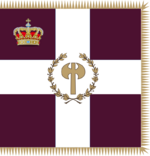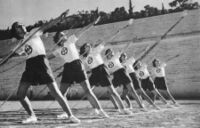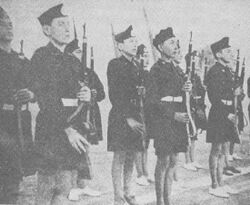National Youth Organization (Paretia)
This article is incomplete because it is pending further input from participants, or it is a work-in-progress by one author. Please comment on this article's talk page to share your input, comments and questions. Note: To contribute to this article, you may need to seek help from the author(s) of this page. |
| National Youth Organization Organização Nacional da Juventude | |
|---|---|
 Flag of the ONJ | |
| Chairperson | Queen Roberta II |
| Founded | 3 January 1926 |
| Dissolved | 1 October 1933 |
| Headquarters | Precea, Paretia |
| Membership | 2.5 million (1930) |
| Ideology | National Functionalism Palmeirism Paretian nationalism |
| Mother party | New Nation of Paretia Party |
The National Youth Organization (Luzelese: Organização Nacional da Juventude), abbreviated ONJ, was the youth wing of the New Nation of Paretia Party, the sole legal political party during the period of Functionalist Paretia. It was created for the framing and political indoctrination of the young Paretians according to the principles of National Functionalism and Novanism. It also was meant to train and help youth learn cooperation and national spirit in their free time.
It was created in 1926 as the successor to the Young PNNP Front, and was more an official part of the Paretian government than the PNNP party itself. It would be apart of the regime's national projects and national rallies. The group became the largest youth functionalist youth movement at the time, with over 2.5 million members, it became an essential part of functionalist society. They would work closely with the Avant-garde de demain, the youth front of the Parti Populaire in Gaullica. During the Great War it worked to train it's youth in combat and medicine. Towards the end of the war many of it's members saw combat, especially in urban battles like the Battle of Precea in 1932.
It was lead by Ivan Montecalvo, a leader of the Visegan wing of the party who was originally a key member of the PNNP who eventually fell out of favor of the party leadership. He was ousted in 1933 and replaced by Cornélia Bastos and she lead the organization until her arrest in 1932.
History
Early Activities
The Youth PNNP Front was founded in 1919 shortly after the formation of the New Nation of Paretia Party, it would become one of the largest youth wings at the time, rivaling that of the SPIO and PDP. It would be a part of the rallies and events of the PNNP. It would be used to train and prepare members for future membership in the Army of the New Nation, the paramilitary wing of the PNNP.
The PNNP was able to succeed very quickly when it worked with scouting groups that had become popular in Paretia in the early 20th century. It also infiltrated the schools, sending advocates to schools and universities to recruit members into the PNNP.
The size of the Youth PNNP Front reached nearly 200,000 in 1925. It became an essential part of the PNNP's political activities. The first leader of the group was Ivan Montecalvo, who was a member of the Paretian scouting groups since his youth, he was able to run the Youth Front with efficiency.
Religious youth groups were also targeted for recruitment, the important of religion in Paretia and in Palmeirist ideology was also still very important in Paretian society, use of religious messaging helped expand the group greatly. The group would eventually become one of the largest youth wings in the world.
Functionalist Rule
After the functionalist takeover in 1925 and the formation of the 7th of November Movement, the Palmeira government would reform much of the PNNP's wings into official government organizations, including the Feminine Section and Reservistas. The Youth Front was reformed and expanded into the National Youth Organization in January 1926. It would include add youth groups from traditionalist, monarchists, and catholic organizations. It would number with over a million members after this.
It would be again lead by Montecalvo. The new National Youth Organization would become a major part of the new government. They would play in role in nearly all facets. Palmeira said that he wanted the youth to be a very active part of his new government, "They will take our shoes once we are gone, like every cell in our body, we die off and are replaced. These children will replace us, I will make sure they will continue to keep the functionalist dream alive after I am gone."
The ONJ would take part of rallies, training, charity, education, and other events. In 1926 the Palmeira government formed the University Paretian Union, a section that's goal is to give education opportunities and teaching new members the different aspects of Functionalist Palmeirism.
The ONJ would have a focus on physical fitness as well, Inácio Torres e Rosário would oversee this section of the ONJ. He would use the ONJ to create "Invictus Champions" out of it's members. The ONJ's physical fitness section would create events for sports and help construct pools and stadiums.
Members of the ONJ would work in different facets of the government, some would work as paperboys for the state newspaper Acima as well as run their own newspaper, A Juventude. Some would work at charitable events such as food drives, often times with the Feminine Section. Female members would often learn cooking and family-centric topics. Bishop Carlos Teixeira would oversee religious events held by the ONJ, ONJ members were required to attend Catholic Churches.
The outbreak of the Great War in 1927 would lead to mobilization of the National Youth Organization. And with the entrance of Etruria the next year they would begin to work in military training, manufacturing, and medical fields alonside the Feminine Section.
Great War
The outbreak of the Great War in 1927 would lead to the ONJ being used in a different manner many of the younger members of the organization were assigned to helping the creation of weapons and supplies in factories. Many female members would become used for hospitals as nurses and assistants. The oldest male members of the ONJ were sent out to fight the war, older female members became frontline nurses. Much of this initially was to help Gaullican forces in northern Euclea and Tsabara, but Etruria's entrance into the war in 1928 would lead to mobilization of the ONJ. Palmeira called this mobilization "A final preparation for the members who have trained themselves to serve the country".
The ONJ would greatly increase in numbers, and the government would have membership of the youth become compulsory in 1929, making it that all Paretians ages 7 to 20, must serve in the ONJ for two years, this was followed by compulsory military service. Palmeira stated that the war was now a war for the life of Paretia as a nation.
As the tide of the war turned towards Etruria's favor by 1932 the military was in need of more forces, the ONJ would begin to form a military unit of youth members, including younger and female members. A rapid training of over 500,000 Paretian children for war was conducted in 1932 and 1933. By 1933 Etrurian forces had won at the Battle of Chineta and were beginning to push deeper into Paretia.
Many of the ONJ who saw combat would see it in the final year of the war in Paretia, at the battles of Encerosa, Ocerto, and Precea. By late 1933 Paretia would have women, elderly, and children in combat roles. During the Battle of Precea over 100,000 ONJ saw combat in the streets of the city. Paretia surrendered in October 1933 after Precea fell, the ONJ was dissolved after.
Activities
The ONJ was a major part of the PNNP's control of the country. The organization participated in rallies, parades, athletic events, and worked on national projects. It also offered military training and environmental protection projects.
The organization has a list of goals for the Paretian youth called the Principals of Palmeirist National Functionalism:
- political education
- physical fitness
- military education
- political outreach
- charity
- education for running camps, shelters, and academies
- respect for the culture of Paretia and the church
- family education for female youth
- loyalty to party, nation, and state
The group also was tasked with creating propaganda for the regime, and ran a newspaper called The Youth (A Juventude).
Organization
The leader of the organization was approved by the National Chief of the New Nation of Paretia Party and the 7th of November Movement Board, Carlos Palmeira. The board of members of the PNNPeM7N would appoint leaders of the organization for Palmeira to approve of.
The organization was divided into different levels and departments. The organization was given a physical education and religion advisor, them being General Inácio Torres e Rosário and Bishop Carlos Teixeira respectively.
There were many different units of the ONJ, such as the University Paretian Union (Sindicato Universitária Paretiana) which was located in university campuses and made of university students. There were sections related to teaching members different goals of the organization as according to the principals of the ONJ. Higher level members of the organization would then be given the ability to teach newer members the different parts of the organization and activities.
The organization also held vocational training competitions which could be between members and regional parts of the organziation, it eventually would compete internationally with other functionalist national youth groups such as in Gaullica, Ardesia, and Piraea.
The organization also had a Agricultural and Rural Section that focused on training for those who live in rural parts of Paretia. As well as sections specifically for youth women and men.
The organizationw as divided by age into different groups, Paritos (7 to 10 years old), Infantes (from 10 to 13 years old), Vanguardistas (from 14 to 16 years old) and Cadetes (from 17 to 20 years old). The basic unit was the squadron, and the commanders were called squad leader, bull, matador and legion.
Symbols
The symbol of the ONJ was the same as the symbol of the PNNP Regime and other functionalist regimes abroad, the labrys axe. The group had a flag that was a purple and white cross with the emblem in the middle.
The group also used youth bulls as the symbol for the younger members of the organization.





